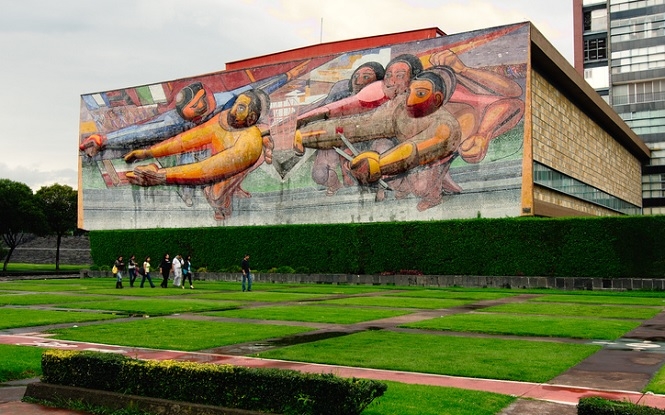Jun

How Mexican Muralist Art Influenced the Modern World
When we speak of Latin American Art, we need to understand the mixed cultural effects that colonization brought. Given the combined effects of the Spanish, Portuguese and French cultures, the beauty of Latin American Art lies in the fact that it’s so diverse.
Latin American Art consists of many subjects and media, among which Mexican Muralism is only one. The movement consisted of painting murals in Mexico’s public spaces such as chapels, schools, government buildings, and more. To this day, Mexicans continue to paint murals in such places as a symbol of personal expression.
Murals were meant to be targeted at illiterate citizens, who would learn the importance of building their country all over again after the revolution. However, the impact went far beyond spreading revolutionary messages. Reviving muralist art in Mexico also meant bringing back an ancient art form.
We can find many mural paintings in ancient civilizations. Full of stories, the muralism was an important decorative and narrative element in old mega structures. And so, this new movement was tackling an old medium with a modernist approach.
It was after the Mexican revolution that the country’s government funded the Mexican Muralist Movement to unite all the people. Their mission was to create awareness among the citizens by promoting concepts of socialism. Having such an important aim meant the artworks would portray themes of education, cultural identity, and progress, and become a beacon of resistance.
In the 1920s, the project was headed by three major artists. These figures known as “The Big Three” were José Clemente Orozco, David Alfaro Siqueiros, and Diego Rivera. Another muralist, Rufino Tamayo, was also active in the same period and so, got the title of being “The Fourth One”. It’s impossible to discuss all artists in one go, but we can go through the different subjects.
For example, we get to see traces of the pre-Columbian era in Tamayo’s work. The violent depiction is clearly inspired by the Spanish Conquest of Native Mexico. He also added his own thoughts to the mix, hoping to instil the love of cultural roots in Mexican people while also showing signs of individualism. We can even see how he has used pre-Conquest elements in his art.
The art scene also included some female artists. The first female muralist was Aurora Reyes Flores, her work revolving around depicting unprotected people. We can also see feminist instances in her painting “Atentado a Las Maestras Rurales” in which a woman is being dragged by her hair by a man holding a book in his hand.
Another female artist, Elena Huerta Muzquiz is credited for creating the largest mural painting in Mexico by a woman. She spent two years completing the 450 square meter work in Saltillo, Mexico. The mural shows two scenes side by side, capturing the 1810 independence of the country while the other scene shows contemporary leaders that progressed the Mexican independence movements.
Rina Lazo was another female Mexican artist, known for working alongside Diego Rivera. He was a role model for her, which inspired her to help him create one of the most prominent murals of the Mexican Revolution, known as the “Sueno de Una Tarde Dominical en la Alameda Central” or “Dream of a Sunday Afternoon in Alameda Central Park.
Lazo was Rivera’s assistant till his last breath - for a total of 10 years. So we can also conclude that male and female artists had started working together. The era was genuinely liberating for every Mexican and people worldwide too.
As time passed, creating murals became a basic form of freedom of expression. The stance on personal expression allowed people to own this rich and unique medium and bring out their ideas in public spaces.
Other subjects also began to be integrated into the movement. Capitalism and technology are two of the most famous ones. It’s one of the reasons why Mexican Muralism even inspired the Chicano Art Movement in the United States.
So it’s no doubt that Mexican murals have inspired people worldwide to view art as something that’s not restricted within galleries and museums. It encouraged that art and murals be painted in public spaces, making rich visuals available for all.
To this day, we can see how people fuse cultural roots with modern and contemporary art. The influence of Mexican Muralism is clear by the use of figures to depict cultural roots along with a sense of individualism and liberation.
Written by David Mansell






